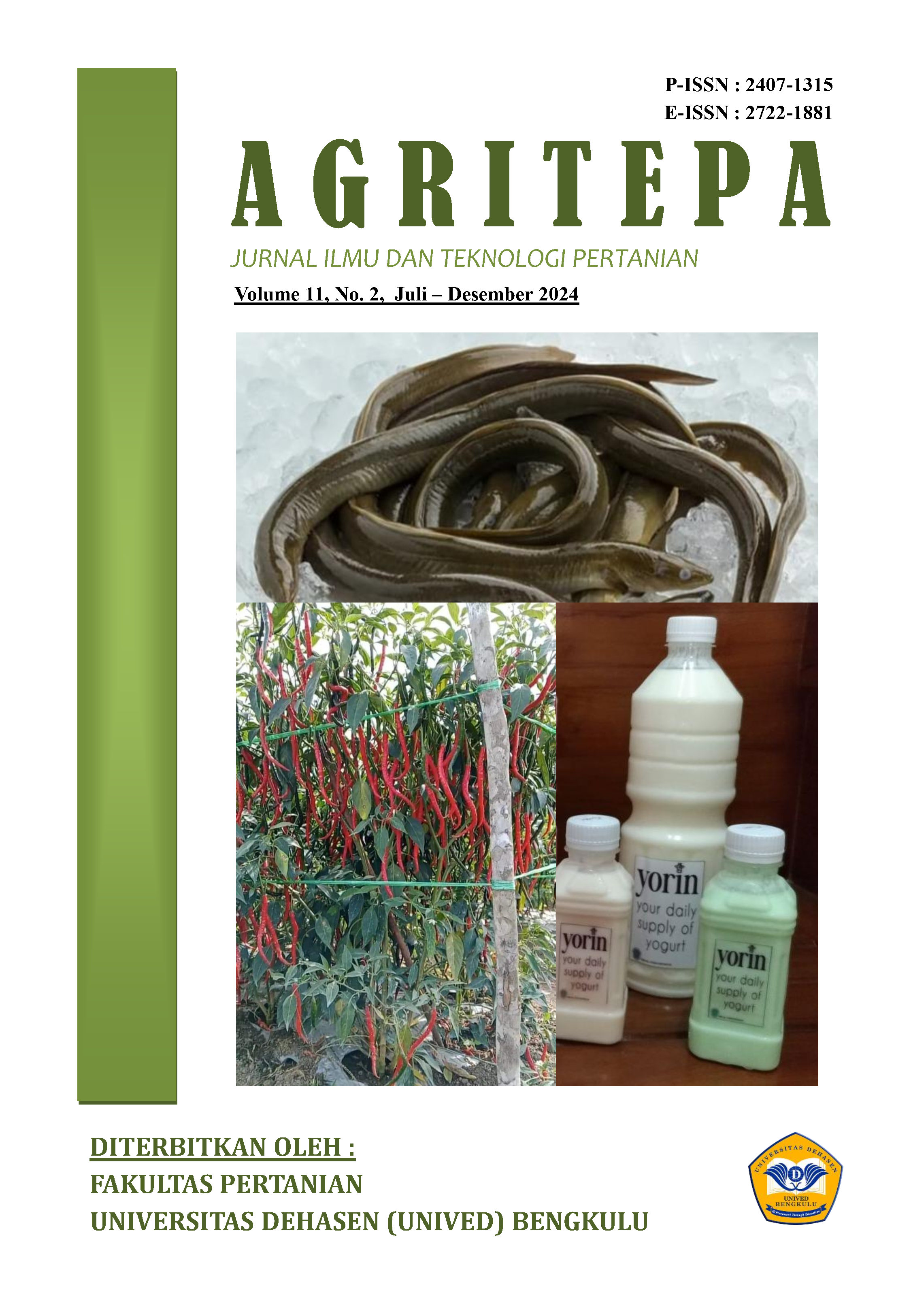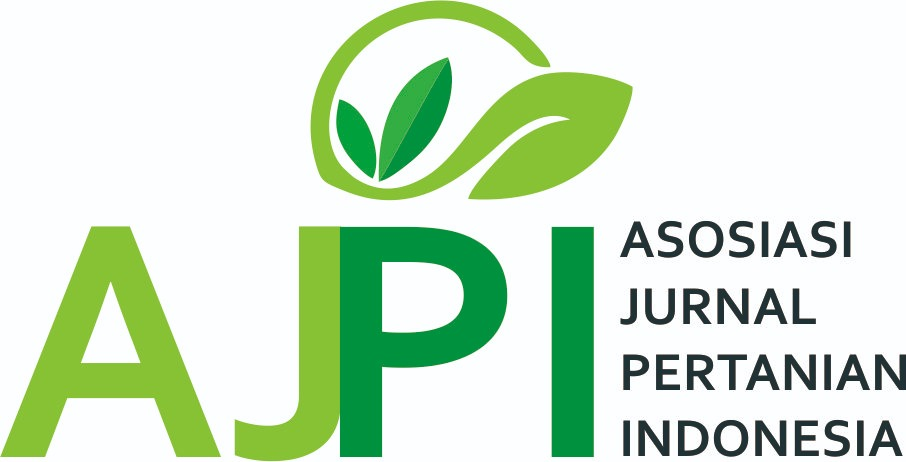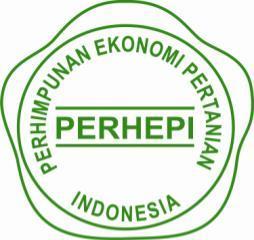The Effect of Feeding Red Beans In Yoghurt On Organoleptic Acceptance And Protein Levels
Abstract
Purpose: This study aims to examine the effect of red bean slurry addition on the organoleptic acceptance and protein content of yogurt. Methodology: The research employed a Completely Randomized Design (CRD) with one factor, namely variations in red bean slurry concentration. Organoleptic analysis was conducted using the Kruskal-Wallis test on attributes such as color, aroma, taste, consistency, and overall quality, involving 30 panelists. The most preferred product underwent protein content analysis using the micro Kjeldahl method. Results: Yogurt with 20% red bean slurry addition (F2) showed the highest organoleptic acceptance. The protein content of F2 yogurt increased from 0.56% to 1.30% after 24 hours of fermentation. Findings: The addition of 20% red bean slurry significantly enhanced the organoleptic acceptance and protein content of yogurt. Novelty: This study reveals the potential of red bean slurry as an additive to improve yogurt's organoleptic quality and protein content. Originality: This research contributes to the development of yogurt products enriched with red bean-based ingredients. Conclusions: Yogurt with 20% red bean slurry (F2) is the most preferred product, showing a significant increase in protein content after 24 hours of fermentation. Type of Paper: Experimental Research Paper.
Downloads
References
Agustine, L. (2018). Identifikasi Total Bakteri Asam Laktat (BAL) pada Yoghurt dengan Variasi Sukrosa dan Susu Skim. Jurnal Dunia Gizi, 1(1), 79–83.
Astawan, M. (2018). Sehat dengan Hidangan Hewani. Penebar Swadaya.
Arum, H. P., & Purwidiani, N. (2014). Pengaruh jumlah ekstrak jahe dan susu skim terhadap sifat organoleptik yoghurt susu kambing etawa. E-journal Boga, 3(3), 116-124.
Siti. Chusnul.(2009). Peranan Streptococcus thermophillus dan Lactobacillus bulgaricus Dalam Proses Pembuatan Yogurt. Jurnal Ilmu Peternakan.4(2) : 47-52.
Jasmine, Oktaria, R., Fadhilla, R., Melani, V., Ronitawati, P., & Angkasa, D. (2020). Stirred Yogurt Berbasis Slurry Kacang Merah ( Phaseolus Vulgaris L ) Dan Sari Buah Naga Merah. Darussalam Nutrition Journal, 4, 82–93.
Kumalaningsih, S., Pulungan, M. H., & Raisyah, R. (2016). Substitusi sari kacang merah dengan susu sapi dalam pembuatan yogurt. Industria: Jurnal Teknologi dan Manajemen Agroindustri, 5(2), 54-60.
Koswara, S. (1995). Jahe dan hasil olahannya. Pustaka Sinar Harapan.
Natalia, D.P., & Ari, T. A. 2014. Potensi Yogurt Kacang Merah terhadap Gangguan Toleransi Glukosa, Kadar Kolesterol, dan Penurunan Berat Badan pada Remaja Putri Obesitas. Jurnal Sumber Daya Pedesaan, Vol. 7: 17-18
Purwantiningsih, T. I., Bria, M. A. B., & Kia, K. W. (2022). Levels Protein and Fat of Yoghurt Made of Different Types and Number of Cultures. Journal of Tropical Animal Science and Technology, 4(1), 66–73. https://doi.org/10.32938/jtast.v4i1.967
Putriningtyas, N. D., & Wahyuningsih, S. (2017). Potensi yogurt kacang merah (Phaseolus vulgaris L) ditinjau dari sifat organoleptik, kandungan protein, lemak dan flavonoid. Jurnal Gizi Indonesia (The Indonesian Journal of Nutrition), 6(1), 37-43.
Romsiah, & Purnamasari, A. (2019). Penetapan Kadar Protein Pada Yoghurt Kemasan yang Dijual di Hypermart Kota Palembang dengan Metode Kjeldahl. Ilmiah Bakti Farmasi, IV(2), 23–28.
Pratiwi, B. M., Rizqiati, H., & Pratama, Y. (2018). Pengaruh substitusi buah naga merah terhadap aktivitas antioksidan, pH, total bakteri asam laktat dan organoleptik kefir sari kedelai. Jurnal Teknologi Pangan, 2(2), 98-105.
Sekarningrum, A. S., & Umar, S. (2020). Pembuatan Yoghurt Sinbiotik Kacang Merah (Phaseolus Vulgaris L.) Dengan Penggunaan Bakteri Asam Laktat Dengan Penambahan Prebiotik. Jurnal Bioindustri (Journal Of Bioindustry), 2(2), 476-486.
Settachaimongkon, S., Nout, M. R., Fernandes, E. C. A., Hettinga, K. A., Vervoort, J. M., van Hooijdonk, T. C., ... & van Valenberg, H. J. (2014). Influence of different proteolytic strains of Streptococcus thermophilus in co-culture with Lactobacillus delbrueckii subsp. bulgaricus on the metabolite profile of set-yoghurt. International Journal of Food Microbiology, 177, 29-36.
Stella. (2014). Kualitas Yoghurt Probiotik Dengan Kombinasi Tepung Kacang Merah dan Susu Skim.Skripsi.Fakultas Teknobiologi. Universitas Atma Jaya. Yogyakarta.
Sukarminah, E., Wulandari, E., & Lembong, E. (2017). Tepung Sorgum Sebagai Pangan Fungsional Produk Sinbiotik. Jurnal Pengabdian Kepada Masyarakat, 1(5), 329–331.
Syainah, E. S. Novita dan R. Yanti. (2014).KajianPembuatanYoghurtdariBerbagai Jenis Susu dan Inkubasi yangBerbedaTerhadapMutudanDayaTerima.JurnalSkalaKesehatan,5(1)
Umaroh, A. (2018). Pengaruh penambahan susu skim dan madu terhadap sifat organoleptik yoghurt kacang merah. Jurnal Tata Boga, 7(2).
Winarno, F. G. 2004. Kimia Pangan dan Gizi. PT. Gramedia. Jakarta
Wirawati, C. U., Dwi, D., & Nirmagustina, E. (2022). Suplementasi Hidrolisat Glukomanan Tepung Porang (Amorphophallus oncophillus) pada Produk Minuman Sinbiotik Suplementation of Konjac (Amorphophallus oncophillus) Glucomannan Hydrolisate in Synbiotic Product. Jurnal Penelitian Pertanian Terapan, 22(1), 37–44. http://dx.doi.org/10.25181/jppt.v17i3.2276
Yusmarini dan R. Efendi. 2004. Evaluasi Mutu Soyghurt Yang Dibuat dengan Penambahan Beberapa Jenis Gula. Jurnal Natural Indonesia. 6(2) : 104- 110.
Copyright (c) 2024 Yenni Okfrianti, Putri Ayu Lestari, Yunita Yunita (Author)

This work is licensed under a Creative Commons Attribution-ShareAlike 4.0 International License.
Author retains the copyright and grants the journal the right of first publication of the work simultaneously licensed under the Creative Commons Attribution-ShareAlike 4.0 License that allows others to share the work with an acknowledgement of the work's authorship and initial publication in this journal











